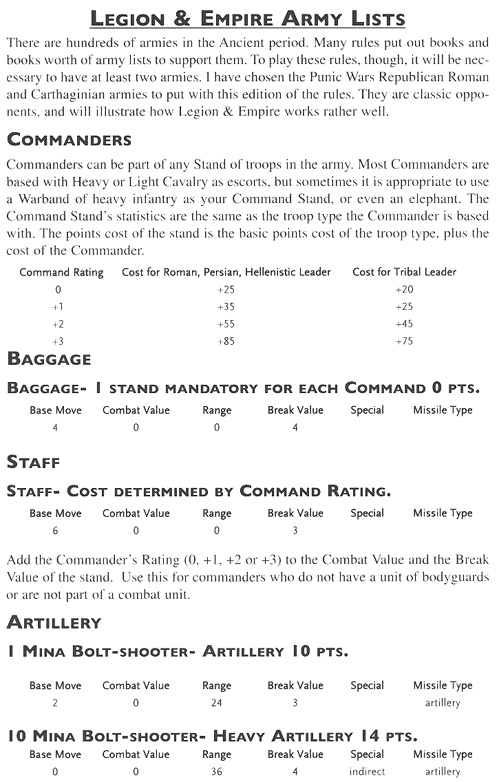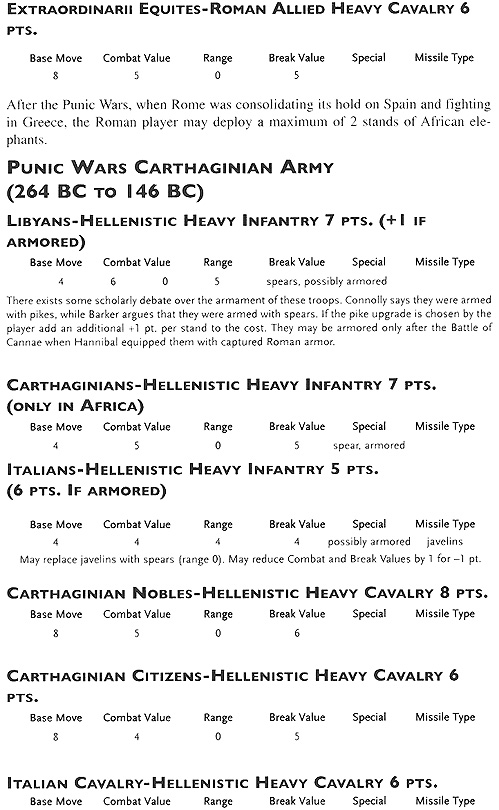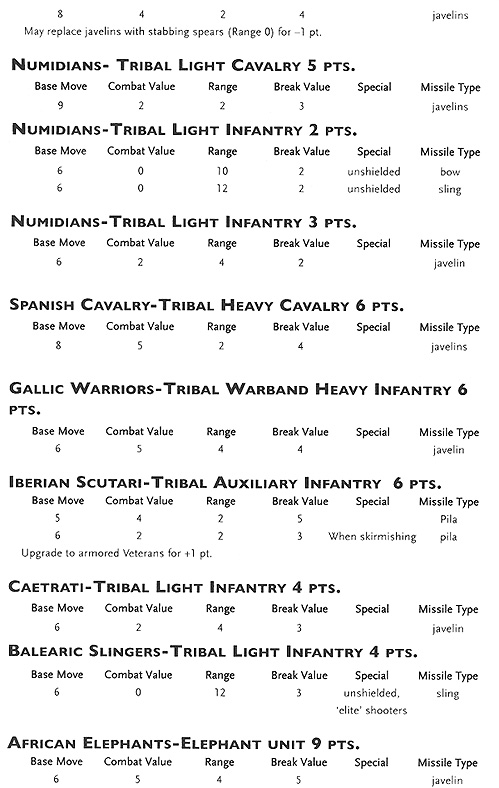Army Lists
There are hundreds of armies in the Ancient period. Many rules put out books and books worth of army lists to support them. To play these rules, though, it will be necessary to have at least two armies. I have chosen the Punic Wars Republican Roman and Carthaginian armies to put with this edition of the rules. They are classic opponents, and will illustrate how Legion & Empire works rather well.
COMMANDERS
Commanders can be part of any Stand of troops in the army. Most Commanders are based with Heavy or Light Cavalry as escorts, but sometimes it is appropriate to use a Warband of heavy infantry as your Command Stand, or even an elephant. The Command Stand's statistics are the same as the troop type the Commander is based with. The points cost of the stand is the basic points cost of the troop type, plus the cost of the Commander.


Roman tactical units of this era were quite small, maniples of 120 men, so a complete line of 10 maniples would be only 2 or 3 stands of figures. Therefore, a slight adjustment of the usual figure scale is necessary to make Roman units large enough to be meaningful in the game. A Roman legion of the Punic Wars era would consist of 2-8 stands of Velites, 4 stands of Hastati, 4 stands of Princeps, 2 stands of Triarii and 2 stands of Equites. For a battle of epic proportions like Cannae where the Romans fielded 8 legions, the players may want to use the normal figure scale.
Traditionally, the Hastati are the youngest, least experienced soldiers, the Princeps are the legionaries "in their prime" and the Triarii are the solid, old veterans. But in reality, the troops were assigned to their unit according to their property qualifications. So an impoverished, but crusty old campaigner may be in the Velites or Hastati, and a young, inexperienced son of a merchant may be in the Triarii or Equites because he can afford some armor. Players may assign different morale values to each line; `green' to the Hastati, `regular' to the Princeps and `veteran' to the Triarii.
A more realistic approach would be to assign the same morale grade to the entire legion since they were raised and trained together. The legions were raised yearly and even if the individual members had considerable military experience they would not have experience acting together until a campaign had been under way for a few years. Any army that has been recently recruited (such as those that fought the Battles of Trebbia, Lake Trasimene and Cannae) must consist of at least 50% green legions and may not have any veteran troops except for the Triarii. After losing 4 legions at Lake Trasimene and 8 legions at Cannae veteran troops would be nonexistent in a Roman army. In fact, after Cannae, the Senate raised 2 legions of freed slaves (unarmored and green, no Triarii). An army fighting the long wars in Spain or Macedonian may have one veteran legion and no green troops.
As the wars progressed, the Romans increased the number of Velites in each Legion. This was either to compensate for manpower shortages or to oppose the large numbers of Carthaginian skirmishers. For the First Punic War, the Romans would have 2-3 stands of Velites per Legion. In the Second Punic War, 4 to 6. By the Third Punic War, 6 to 8 stands per Legion was common.
Roman armies were composed of equal numbers of Roman and Allied infantry, but each Allied legion had double or more the amount of cavalry (4-6 stands). A Consul would typically command 2 Roman and 2 Allied Legions. Treat Latin allied infantry as Romans for game purposes. Armies in Italy may have one unit of Cretan archers, and in the last years of the Italian campaigns they may have limited numbers of Numidian and Spanish deserters. Armies in Spain may have Spanish Heavy Infantry, Light Infantry and Cavalry as allies. Armies in Africa may have Numidian allies during the Second and Third Punic Wars.
To guard the Consul and act as an advance guard the Romans would often select the best 1600 Latin infantry and the best 600 Latin cavalry. These elite troops were called extraordinarii. A Roman army may have a maximum of 4 stands of each.



Carthaginian armies varied widely in composition. The players must agree about whether they are playing a battle in Africa, Spain or Italy.
In Italy, the Carthaginian player can obviously have Hannibal as a +3 Commander in Chief, as well as other +2 lieutenants. Most of Hannibal's elephants did not survive the first Italian winter. Therefore he can only have 2 stands of elephants at the Battle of Trebbia. After that he may not have any until after the Battle of Cannae when he was reinforced from Carthage and may have a maximum of 4 stands. For every 2 stands of Libyan Heavy Infantry, the player may select 1 stand each of Spanish Iberian Heavy infantry, Numidian Light Infantry, Spanish Light Infantry and Balearic slingers. For each stand of Libyans he must also have I to 3 stands of Gallic Warband infantry. One quarter to one third of the army strength must be cavalry. For each stand of Spanish Heavy Cavalry the player may select 2 stands of Numidian and 2 stands of Gallic cavalry. After the Battle of Cannae, many Italian cities allied themselves with Hannibal; for games after this decisive battle, Hannibal may have 1 unit of Italian cavalry and I stand of Italian infantry for every 2 stands of other heavy infantry in his army.
In Spain, the Carthaginian player has less capable commanders. Most of them should be 0 or +1 with only one +2 leader at best. He cannot have any Gallic troops. For every stand of Libyan Heavy Infantry, he must have at least 1 stand of Spanish heavy infantry. Spanish troops may be Iberian, Celt-Iberian or Lusitanian. He may have I stand of Light Infantry for every 2 stands of heavy infantry. Half of the Light Infantry is Spanish, the rest is Numidian and Balearic. The Carthaginian player may deploy a maximum of 6 elephants. One quarter to one third of the Carthaginian army strength must be cavalry. He may have 1 unit of Citizen Heavy cavalry. The rest of the cavalry strength is equally divided between Numidian and Spanish cavalry.
In Africa, the Carthaginian player has more access to citizen levies and elephants. For every stand of Libyan Heavy Infantry, the player must have 1 stand of Carthaginian Citizen Heavy Infantry. He may also select 1 stand of Numidian or Balearic light infantry. One quarter to one third of the army must be cavalry. The player may have one unit of Carthaginian Nobles. For every stand of Noble or Citizen Heavy Cavalry, he must have two stands of Numidian Light Cavalry. The Carthaginian player may deploy up to 12 elephants. For the Zama campaign at the end of the Second Punic War, the Carthaginian player may have Gallic and Spanish Heavy Infantry in his Order of Battle, at the ratio of 1 stand per stand of Citizen Infantry.
All Carthaginian units should be from 2 to 4 stands in strength, except Gallic warbands, which should be 4 to 6 stands strong.
Back to MWAN # 132 Table of Contents
Back to MWAN List of Issues
Back to MagWeb Magazine List
© Copyright 2004 Legio X
This article appears in MagWeb.com (Magazine Web) on the Internet World Wide Web.
Other articles from military history and related magazines are available at http://www.magweb.com